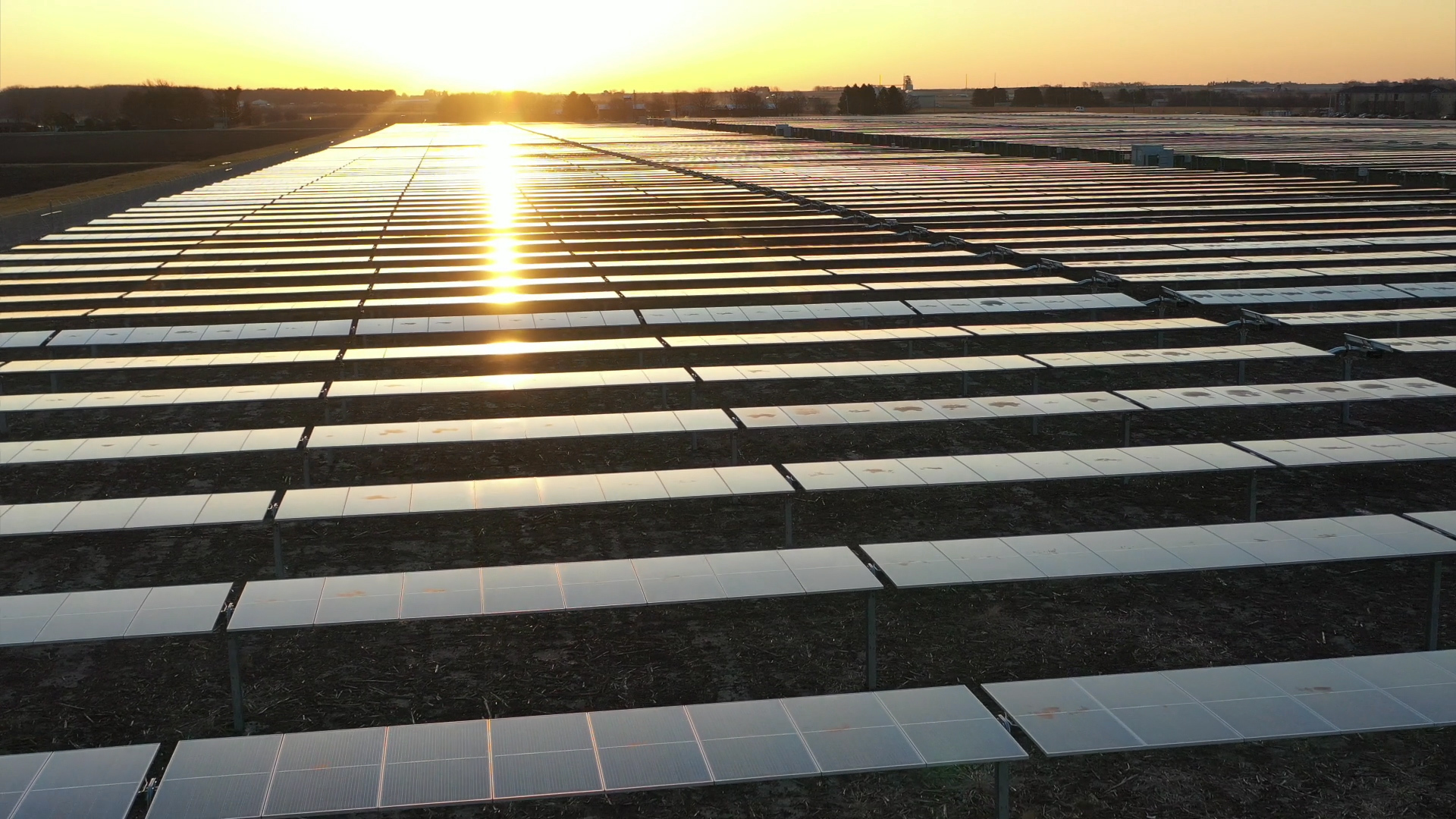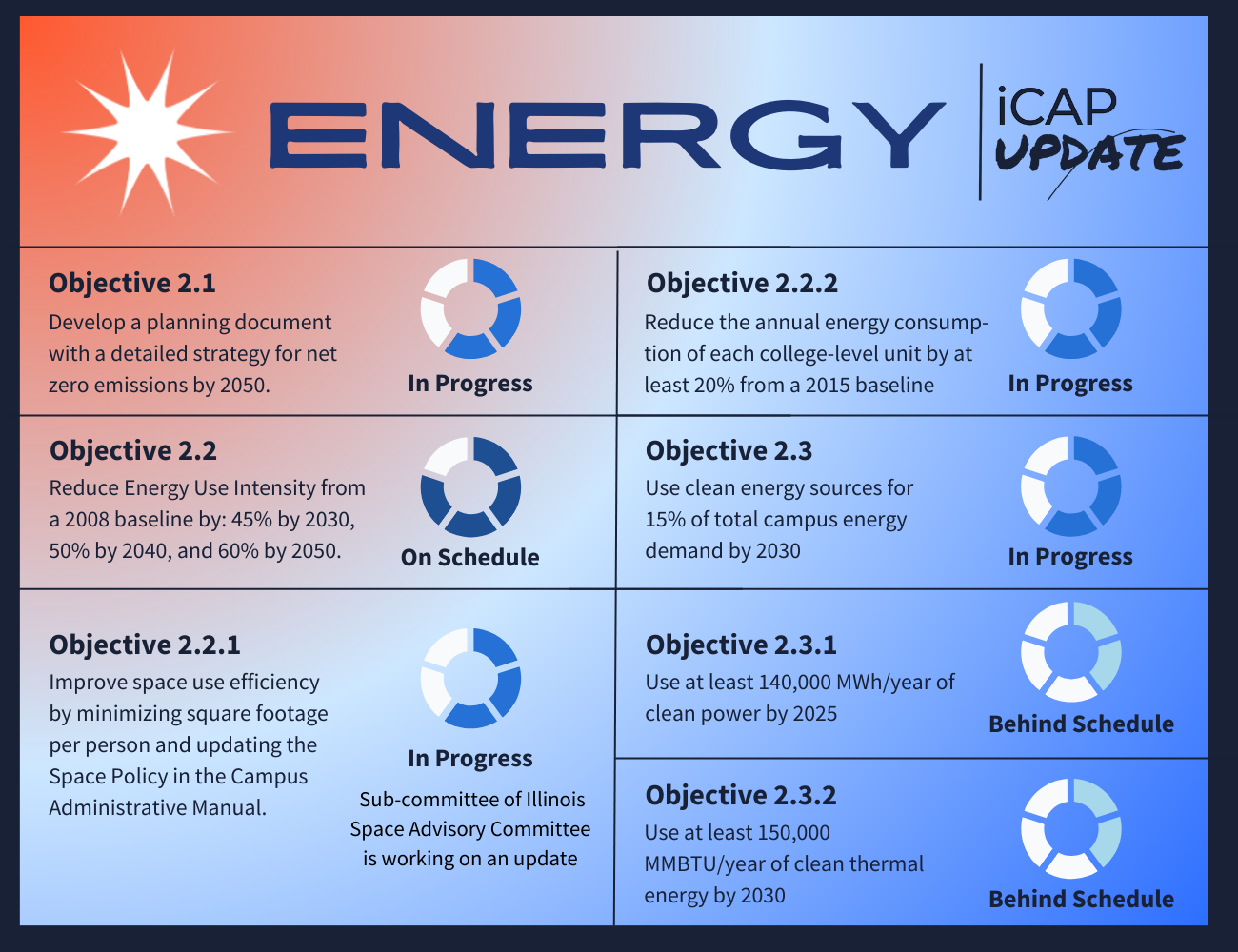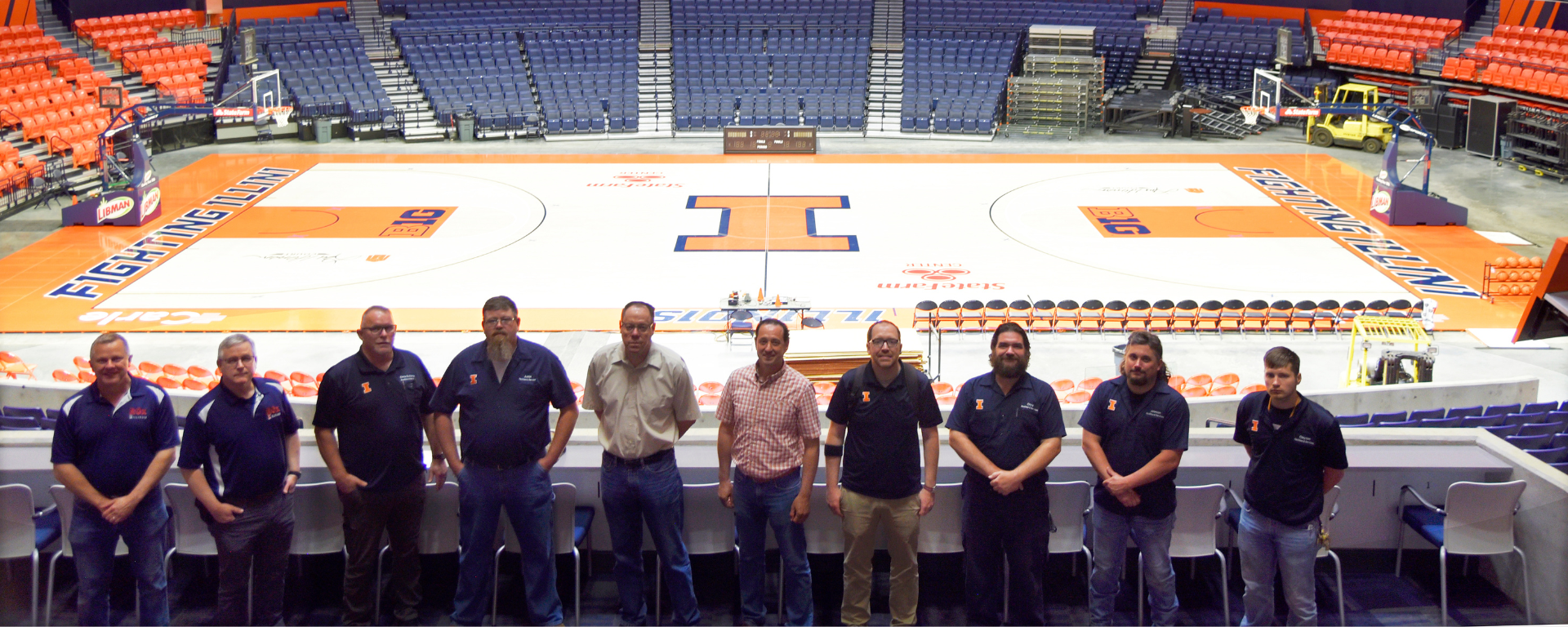
The University of Illinois Urbana-Champaign is already past the halfway point from Illinois Climate Action Plan 2020 to iCAP 2025. It’s time to check in with each of the iCAP topical chapters to gauge campus progress, address the challenges our campus faces, and celebrate some achievements. To begin our series, iSEE Communications Intern Gabe Lareau examines the Energy chapter to see if the university community is on track to reach its goal of net zero carbon by 2050. View the full series >>>

An aerial view of Solar Farm 2.0 at sunrise. Credit: University of Illinois
There is a reason “Energy” is the first chapter in the Illinois Climate Action Plan (iCAP). Its generation — which is still largely based in fossil fuels here at the University of Illinois, in the United States, and globally — is the largest greenhouse gas emitter by a wide, and increasingly unsustainable, margin: nearly 75% globally according to Our World in Data.
It should come as no surprise that generating enough electricity to charge everyone’s laptops, light up Memorial Stadium, and keep the lab fume hoods running is a Herculean effort. We Illini require enough Joules — 3.9 quadrillion — to sustain 25,000 households. And while that means we’re able to stay warm in the winter, it also carries with it the unfortunate reality that campus is an enormous tailpipe for greenhouse gases and a significant contributor to climate change. In 2019, 86% of the university’s carbon emissions came solely from our energy use.
Campus’ most visible example of carbon emissions is that towering smokestack on Oak Street, a block from the Ikenberry Commons. Abbott Power Plant has been campus’ main energy co-generation facility since its construction in 1941. Co-generation because, in addition to providing steam heat directly to 23.7 million square feet of floor space, it supplies a lot of campus electricity. To be fair, without that co-generation, our carbon emissions would be much higher. But Abbott burns both natural gas and a small and declining amount of coal to satisfy a whopping 70-75% of the energy demand on campus, marking it as campus’ largest greenhouse gas emitter.

The University of Illinois campus has made significant strides in building new sources of renewable energy, cutting energy demand, and making existing facilities more efficient. But work remains in minimizing campus square footage growth, maximizing renewable energy output, and finding a source of clean thermal power.
Herein lies the good and bad news for the Energy iCAP Team. Thirteen years ago, when the original iCAP was signed, campus energy was provided entirely by fossil fuels and grid-purchased electricity. Since then, working with Facilities & Services (F&S) and with some funding support from the Student Sustainability Committee (SSC), the Energy Team has seen campus increase renewable-power use to 12%, which is nearly a percent every year on average.
With the second revision of the iCAP in 2015, Solar Farm 1.0 officially came online. This 21-acre, 18,867-panel solar array along Windsor Road generates 2% of campus electricity demand and offers a nice visual indicator of where the U of I stands on its commitment to renewables. It numbers among the country’s largest on-campus solar fields, though it pales in comparison to its successor.
More than twice as big as Solar Farm 1.0 and responsible for tripling campus’ renewable electricity generation is Solar Farm 2.0. Combined with the university’s Rail Splitter Wind Farm Power Purchase Agreement (PPA) and other renewable campus building installations — rooftop solar, geothermal systems, and a biomass boiler at the Energy Farm among others — this massive solar field has made significant strides in weaning campus off fossil fuels as an energy source since it came online in January 2021.
These advancements in campus renewable energy are surely cause for celebration, and it’s clear to all involved that they must continue if the university is to reach its iCAP goal of net zero carbon by 2050. In 2021, campus reached its 2025 greenhouse emission goal four years early — a massive step in the right direction, albeit likely because of the campus’ shutdown during the COVID pandemic. The iCAP’s objectives to keep this momentum going, while numerous, are categorically twofold: mitigation and transformation.
As most of campus energy is currently supplied via fossil fuels, it’s in the university’s — and the climate’s — best interest to reduce, and certainly not further increase, its energy use. Objectives within the iCAP touch on this across a variety of areas: reducing Energy Use Intensity of university facilities (2.2); improving space efficiency (2.2.1); and reducing energy consumption at each college-level unit (2.2.2).
According to the Energy Team, these goals can be most effectively fulfilled by following the university’s Net Zero Space Growth Policy and through the Facilities & Services’ Retrocommissioning, Systems and Controls, and Energy Performance Contracting teams. These groups are the university’s most effective way to simultaneously mitigate energy use and maximize efficiency.
As the unsung climate heroes of campus, Retrocommissioning team members retrofit campus buildings to increase their efficiency and reduce operating costs. That might include repairing or replacing Heating, Ventilation, and Air Conditioning (HVAC) components, adding temperature controls and occupancy sensors, installing new ductwork, and more.
Energy savings in newly retrocommissioned buildings usually hover around 20% per year, according to the Energy Team. This not only prevents literal tons of carbon emissions but saves the university millions of dollars a year.

A Facilities & Services retrocommissioning team at the State Farm Center. Credit: F&S
Construction of new spaces on campus, too, affects energy demand; the more buildings there are, the more energy campus will use. That’s why, in accordance with the iCAP 2010, the university adopted a Net Zero Space Growth Policy in 2015. In sum: for every square foot of space constructed, an equal amount must be removed.
Instead, F&S estimates that the built square footage of campus will increase by 278,000 by 2030. New, perhaps emission-heavy, energy will have to supply those spaces. However, new campus construction projects will be more efficient than in years past, as Illinois state law requires new buildings to be certified at the Leadership in Energy and Environmental Design (LEED) silver level. Many campus buildings have even gone beyond that — the Electrical and Computer Engineering Building (ECE) and Business Instructional Facility (BIF) are both LEED platinum, the former being a net zero building altogether.
Fortunately, even with the addition of new buildings, campus electricity use has been on the decline. This is thanks in part to the university’s commitment to LED bulbs, F&S Utilities & Energy Services’ conservation programs, improvements in technology, changes at the campus supercomputing facility, and fantastic student programs like Illini Lights Out, which turned off almost 40,000 bulbs during the 2022-23 academic year, saving 47 tons of CO2 emissions. The efforts of individual campus members are an essential piece of the overall campus effort as well. Even though turning off your lights or air conditioner when they’re not needed may seem insignificant, all that saved energy adds up quickly.
The rest of the iCAP 2020’s energy objectives deal with how the university generates its energy, which includes electricity (power) as well as heating and cooling (thermal energy). The iCAP details rather ambitious goals of 15% campus-wide clean energy by 2030 (2.3), with at least 140,000 MWh/year of clean power by 2025 (2.3.1), and 150,000 British Thermal Units’ (MMBTU) worth of clean thermal energy by 2030 (2.3.2).
For the objective regarding campus renewable energy, the latest figures available are from iCAP 2020, which reported about 3% of total campus power use coming from renewable sources — mostly the Rail Splitter Wind PPA and Solar Farm 1.0. Keep in mind, this was before Solar Farm 2.0 came online. Since Solar Farm 2.0 triples campus renewable power output, the university supplied 9% of its electrical demand from renewables as of 2021.
To reach the overall 15% clean energy target within the next seven years will require additional large-scale projects equivalent to Solar Farm 2.0. Recognizing this, the Energy Team has said that the possibility of the university entering a power-purchase agreement with an off-campus Solar Farm 3.0 is increasing.
As another clean energy alternative, a separate team has proposed a campus nuclear microreactor and is developing a construction permit — part of a lengthy implementation process. Previously, the TRIGA Mark II nuclear reactor operated safely on campus for nearly 40 years; new safety features on a microreactor can “withstand the worst possible accidents without the need for active intervention,” according to project head Caleb Brooks, Associate Professor of Nuclear, Plasma, and Radiological Engineering. Or, as former Energy Team member Tyler Swanson put it, “This isn’t your grandpa’s nuclear reactor.”
Other projects that offers promise are geothermal heating and cooling networks at the new Steven S. Wymer Hall and Doris Kelly Christopher Extension Building. If approved, they would further increase the university’s renewable energy profile and set an example for other college-level units to follow.
Various green energy projects, mostly small-scale solar, have also been proposed to the Student Sustainability Committee that would further the university’s 15% renewables objective.
Several graduate students have cataloged more than 178 campus buildings that could be fitted with their own solar arrays, as space for on-campus solar fields is in short supply. The Energy Team is looking into the possibility of rooftop solar at the Education Building. And the Activities and Recreation Center, with its large footprint and bare roof, consistently comes up as a viable candidate for more rooftop solar — a possibility that Campus Recreation Assistant Director of Facility Operations Mike Merriman has expressed interest in.
Another building consistently tagged as a potential location for a solar array is Abbott Power Plant. Though still conjecture at this point, rooftop solar panels at Abbott, combined with the proposed microreactor, could change a coal and natural gas plant into a diversified energy generation facility.
While some of the above projects might come to fruition, to complete our clean energy objectives, Solar Farm 3.0 would have to be online by 2030. Campus would also have to find new ways to supply clean electricity and thermal power in order to reach objectives 2.3.1 and 2.3.2 even with the addition of major renewable infrastructure projects like the Hydro-Systems Lab Geothermal Foundations, Campus Instructional Facility’s geothermal network, and Solar Farm 2.0.

Abbott Power Plant supplies 70-75% of campus energy demand. Credit F&S
In the next two decades, the University of Illinois will have to achieve all the iCAP Energy chapter specifies and more to reach net zero carbon by 2050. More solar arrays and wind energy purchases will help achieve these goals, but no educational institution has achieved a perfect score on the Association for the Advancement of Sustainability in Higher Education’s (AASHE) “Greenhouse Gas” category on its Sustainability Tracking And Rating System (STARS) rating without purchasing carbon offsets. Currently, out of a maximum score of 8, the University of Illinois stands at a 3.15.
As a world-class institution, the University of Illinois’ goal is to set an example to other institutions in the Big Ten and the country to, as Chancellor Robert J. Jones said in his iCAP 2020 preface, “make a better and more sustainable world for the students, staff, and faculty who follow us.”
For the iCAP, staying on schedule is paramount, as the failure to complete one or more goals by decade’s end puts added stress on our successors to pick up the slack in years to come. On the other hand, if we complete our objectives and stay on track, net zero by 2050 is a real possibility and would spell an enormous victory for the University of Illinois and the planet.
In the iCAP, and certainly in our ever-warming climate, that starts with energy.